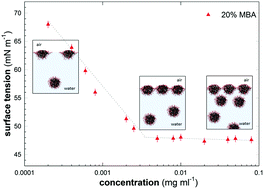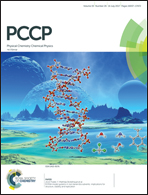Adsorption versus aggregation of NIPAM nanogels: new insight into their behaviour at the air/water interface as a function of concentration†
Abstract
We have used neutron reflectivity (NR) measurements in combination with dynamic light scattering (DLS), surface tension and ellipsometry, to study the adsorption behaviour at the air/water interface of N-isopropylacrylamide-based nanogels as a function of concentration. The data provide clear evidence that the nanogels are adsorbed at the interface in a strongly deformed shape and forming a multi-layer where the thickness increases with nanogel concentration in the bulk. The combination of surface characterisation techniques and bulk studies indicate that interfacial film formation is preferred over bulk aggregation. This observation at the air/water interface supports the Derjaguin prediction, that a sphere's interaction with a plane (the thick adsorbed nanogel layer at interface) is much larger than nanogel–nanogel (sphere–sphere) association in the bulk. These findings, in particular the changes in conformations and the thick layer adsorption at the interface as a function of concentration, impact significantly on a number of applications for which nanogels are currently being investigated. These results contribute to the understanding of the behaviour of soft colloids at the interfaces.



 Please wait while we load your content...
Please wait while we load your content...